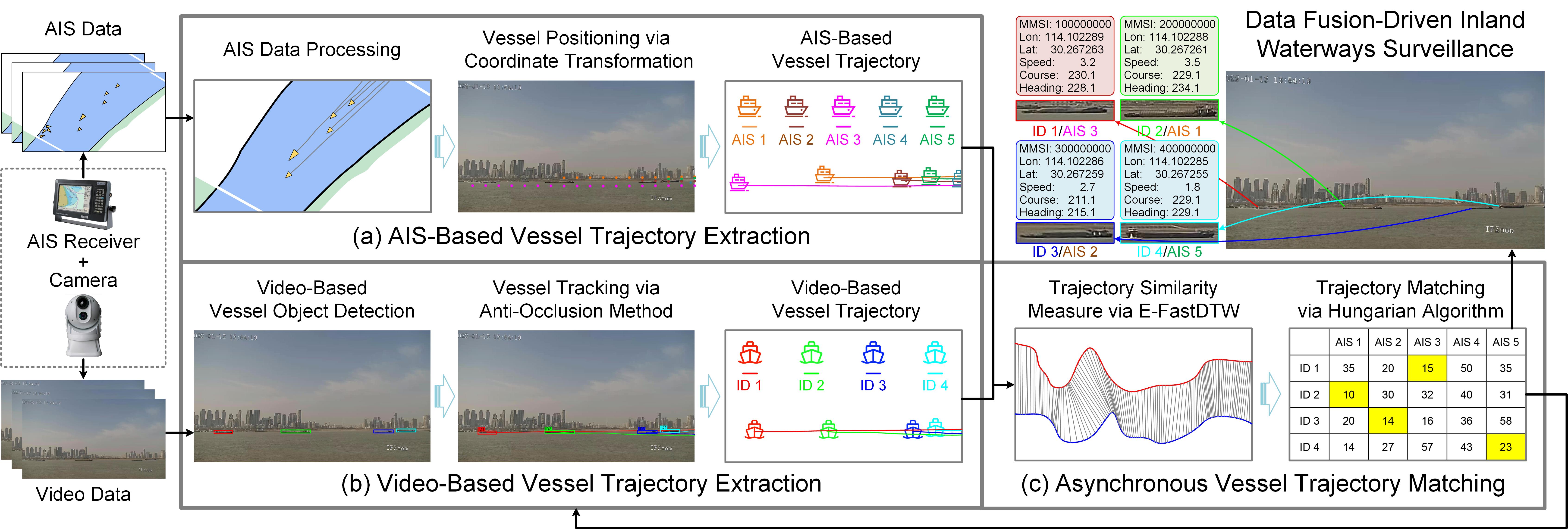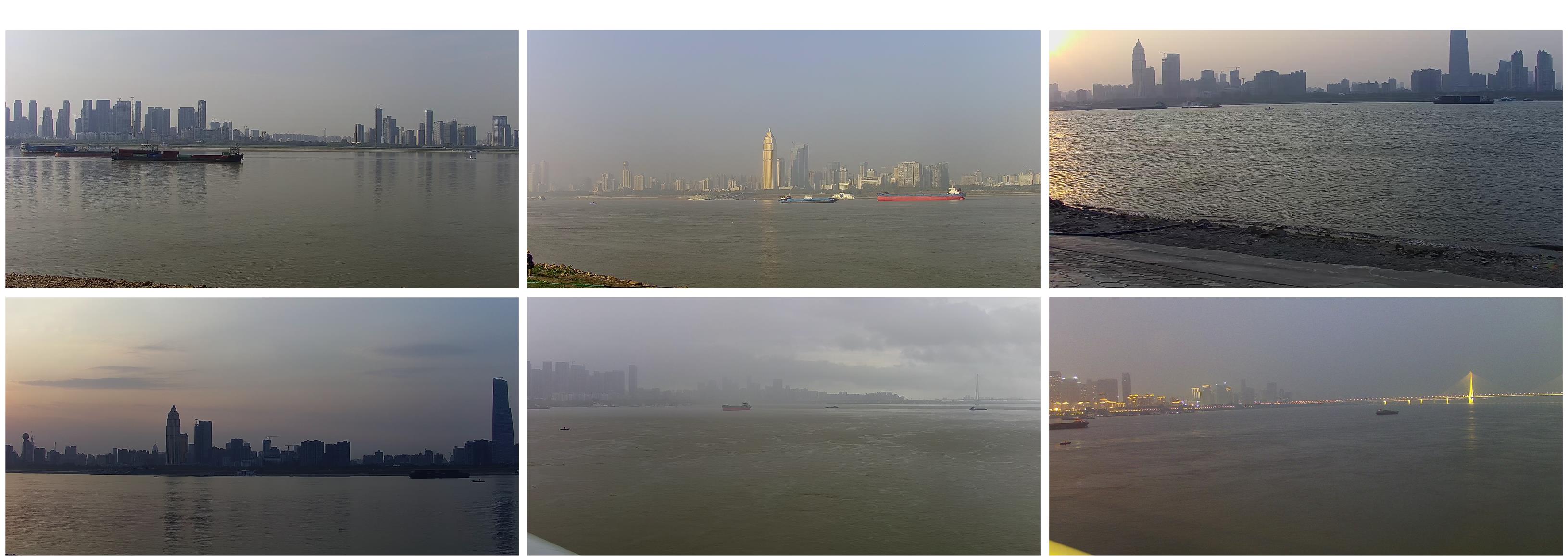Asynchronous Trajectory Matching-Based Multimodal Maritime Data Fusion for Vessel Traffic Surveillance in Inland Waterways
Yu Guo, Ryan Wen Liu* , Jingxiang Qu, Yuxu Lu, Fenghua Zhu* , Yisheng Lv
(* Corresponding Author)
IEEE Transactions on Intelligent Transportation Systems
Introduction: In this work, we first extract the AIS- and video-based vessel trajectories, and then propose a deep learning-enabled asynchronous trajectory matching method (named DeepSORVF) to fuse the AIS-based vessel information with the corresponding visual targets. In addition, by combining the AIS- and video-based movement features, we also present a prior knowledge-driven anti-occlusion method to yield accurate and robust vessel tracking results under occlusion conditions.
- Python3.7
- easydict 1.11
- geopy 2.4.1
- pyproj 3.2.1
- fastdtw 0.3.4
- pytorch 1.13.1
- cuda 11.7
- pandas 1.3.5
- numpy 1.21.6
- Save ckpt.t7 to
DeepSORVF/deep_sort/deep_sort/deep/checkpoint/folder. - Save YOLOX-final.pth to
DeepSORVF/detection_yolox/model_data/folder. - Set data dir by
parser.add_argument("--data_path", type=str, default = './clip-01/', help='data path'). - Run
main.py.
draw_org.py is used to simultaneously visualize the ais-based trajectory (blue line), target detection box (red box), and fusion results (black text). It can be enabled by modifying import draw in main.py to import draw_org.
Test Data: clip-01
The FVessel benchmark dataset is used to evaluate the reliability of AIS and video data fusion algorithms, which mainly contains 26 videos and the corresponding AIS data captured by the HIKVISION DS-2DC4423IW-D dome camera and Saiyang AIS9000-08 Class-B AIS receiver on the Wuhan Segment of the Yangtze River. To protect privacy, the MMSI for each vessel has been replaced with a random number in our dataset. As shown in Figure 1, these videos were captured under many locations (e.g., bridge region and riverside) and various weather conditions (e.g., sunny, cloudy, and low-light).
Performance on FVessel_V1.0
| Name | MOFA (%) | IDP (%) | IDR (%) | IDF (%) |
|---|---|---|---|---|
| video-01 | 79.94 | 89.35 | 90.76 | 90.05 |
| video-02 | 73.19 | 83.27 | 91.60 | 87.23 |
| video-03 | 96.45 | 99.23 | 97.20 | 98.20 |
| video-04 | 98.08 | 99.45 | 98.63 | 99.03 |
| video-05 | 89.19 | 93.46 | 95.91 | 94.67 |
| video-06 | 91.17 | 96.04 | 95.08 | 95.56 |
| video-07 | 96.81 | 99.59 | 97.21 | 98.39 |
| video-08 | 82.28 | 99.64 | 82.58 | 90.31 |
| video-09 | 98.45 | 100.00 | 98.45 | 99.22 |
| video-10 | 88.74 | 90.42 | 99.26 | 94.63 |
| video-11 | 97.66 | 99.29 | 98.36 | 98.83 |
| video-12 | 95.45 | 99.06 | 96.36 | 97.69 |
| video-13 | 84.82 | 94.82 | 89.72 | 92.20 |
| video-14 | 93.10 | 97.82 | 95.22 | 96.50 |
| video-15 | 95.88 | 97.19 | 98.74 | 97.96 |
| video-16 | 98.68 | 100.00 | 98.68 | 99.33 |
| video-17 | 90.02 | 93.80 | 96.39 | 95.08 |
| video-18 | 74.49 | 83.57 | 92.72 | 87.91 |
| video-19 | 96.62 | 98.31 | 98.31 | 98.31 |
| video-20 | 96.74 | 98.66 | 98.07 | 98.36 |
| video-21 | 76.43 | 87.03 | 89.82 | 88.40 |
| video-22 | 96.82 | 99.35 | 97.45 | 98.39 |
| video-23 | 94.71 | 98.91 | 95.77 | 97.31 |
| video-24 | 94.70 | 98.34 | 96.33 | 97.32 |
| video-25 | 91.49 | 97.66 | 93.73 | 95.66 |
| video-26 | 97.44 | 99.11 | 98.32 | 98.72 |
| Average | 91.13 | 95.90 | 95.41 | 95.59 |
We deeply thank Jianlong Su from the School of Computer and Artificial Intelligence in Wuhan University of Technology who performs the data acquisition and algorithm implementation works.
@article{guo2023asynchronous,
title={Asynchronous trajectory matching-based multimodal maritime data fusion for vessel traffic surveillance in inland waterways},
author={Guo, Yu and Liu, Ryan Wen and Qu, Jingxiang and Lu, Yuxu and Zhu, Fenghua and Lv, Yisheng},
journal={IEEE Transactions on Intelligent Transportation Systems},
volume={24},
number={11},
pages={12779--12792},
year={2023}
}
The DeepSORVF is available for non-commercial research purposes only. If you have any questions, please get in touch with me (guoyu65896@gmail.com).
https://github.com/bubbliiiing/yolox-pytorch
https://github.com/dyh/unbox_yolov5_deepsort_counting/tree/main/deep_sort









